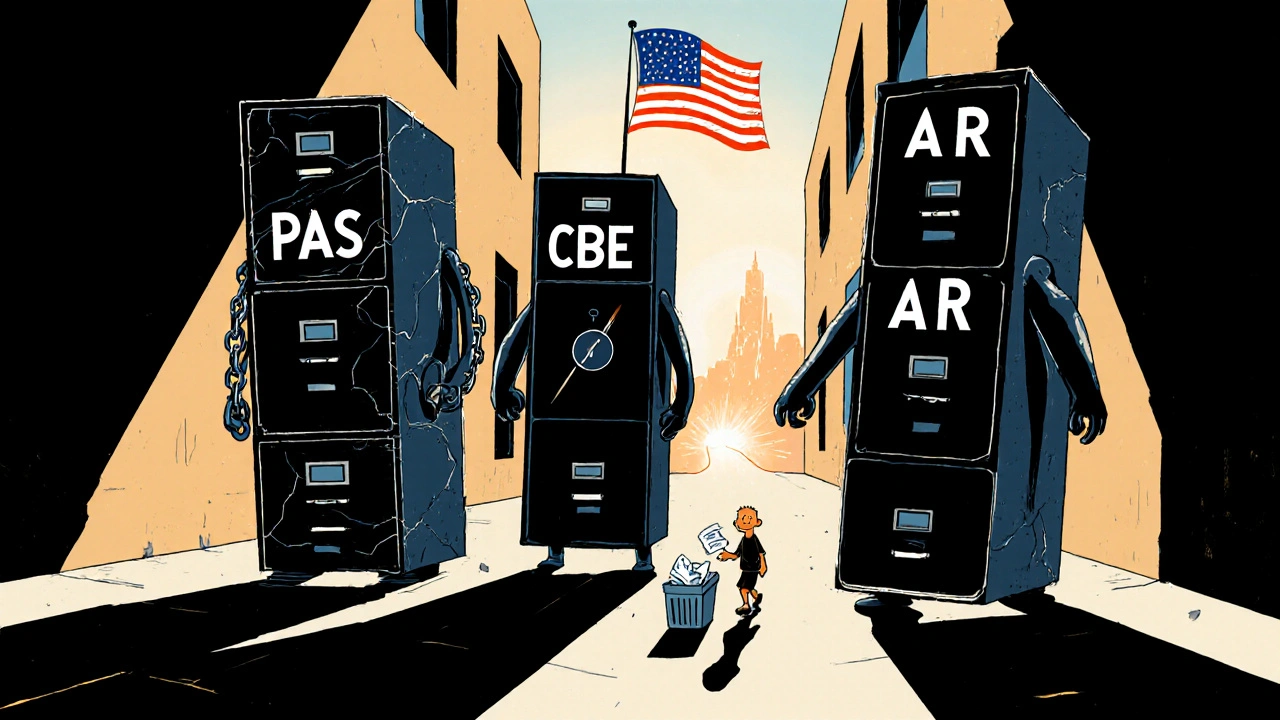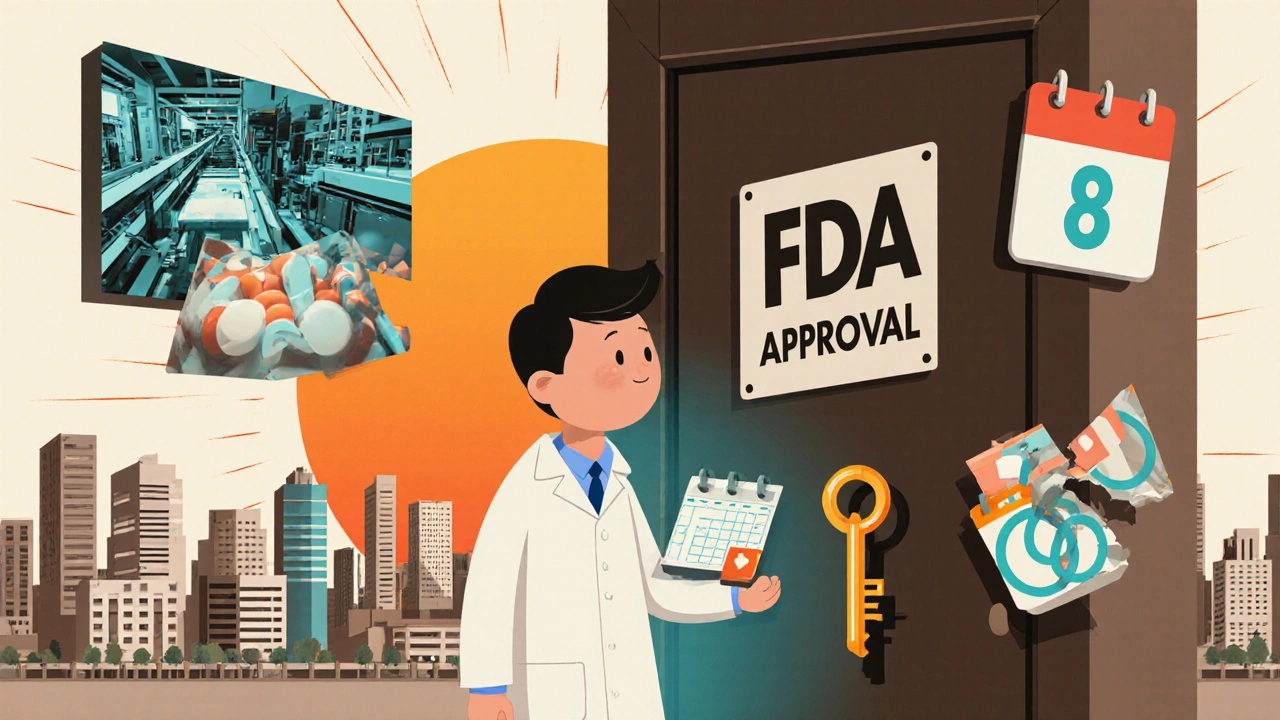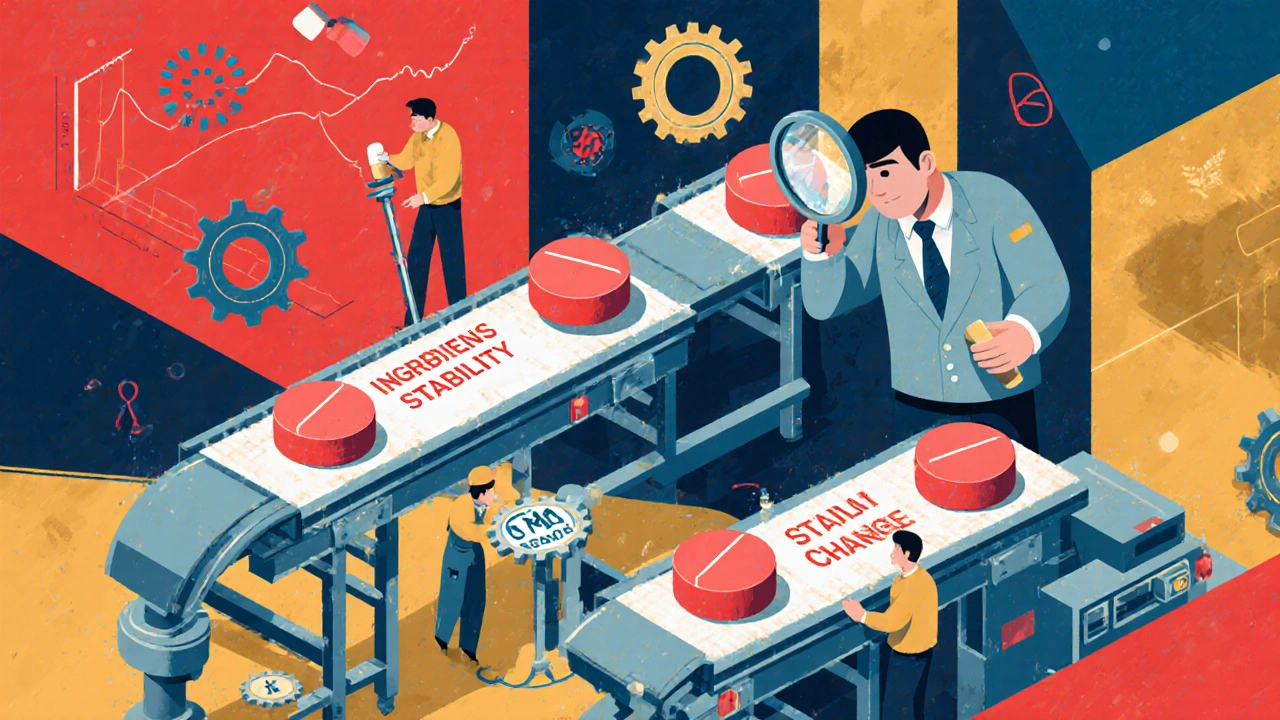When a generic drug hits the market, it’s not the end of the story - it’s just the beginning of a long, regulated lifecycle. The FDA doesn’t just approve a drug and walk away. If the manufacturer makes even a small change to how it’s made - the equipment, the process, the location, or the ingredients - the FDA may require a full re-evaluation. This isn’t bureaucracy for the sake of it. It’s about making sure the generic you pick up at the pharmacy is still exactly the same as the one the FDA originally approved. But what kinds of changes actually trigger that re-evaluation? And why does it take so long?
What Counts as a Manufacturing Change?
Not every tweak matters. If a factory swaps out a single screw on a tablet press and the product still meets every quality test, the FDA likely won’t care. But if the change affects the drug’s identity, strength, purity, or quality - that’s a different story. These are called Chemistry, Manufacturing, and Controls (CMC) changes. They’re the backbone of generic drug regulation.
Common triggers include:
- Switching to a new supplier for the active ingredient
- Changing the manufacturing facility, even within the same country
- Scaling up production from 1 million to 10 million tablets per batch
- Using a new machine or process, like switching from batch to continuous manufacturing
- Modifying the formulation - adding a different binder or coating
- Updating testing methods or tightening specifications for impurities
According to FDA data from 2018-2022, manufacturing process changes made up nearly 16% of all post-approval submissions. Facility transfers and analytical method changes were also top triggers. These aren’t rare events. In fact, they’re so common that the FDA has built a whole system to handle them.
The Three Tiers of FDA Review
The FDA doesn’t treat every change the same. It uses a risk-based system with three categories:
- Prior Approval Supplements (PAS) - These are the big ones. You can’t make the change until the FDA says yes. This applies to changes that could seriously affect safety or effectiveness - like a new synthetic route for the drug substance or moving production to a foreign plant. PAS reviews take an average of 10 months, and complex cases can stretch to 14 months or more.
- Changes Being Effected (CBE) - These are medium-risk changes. You can implement them immediately, but you must notify the FDA within 30 days (CBE-30) or even just 0 days (CBE-0) for minor updates. This category covers things like changing a label or adjusting an in-process control.
- Annual Reports (AR) - The lowest risk. These are small, well-understood changes - like switching to a different brand of the same type of excipient. You just report them once a year in your annual report. No pre-approval needed.
The problem? Many manufacturers struggle to know which category their change falls into. A 2023 survey of 127 generic drug companies found that 78.4% had trouble classifying complex changes. One company spent 18 months getting approval for a tablet press upgrade - even though the final product met all specs. The FDA didn’t reject it; they just asked for more data, over and over.
Why Does It Take So Long?
It’s not just paperwork. For a PAS, the FDA expects:
- Full chemistry and manufacturing data comparing old and new versions
- Stability studies showing the drug lasts as long after the change
- Proof the drug is still bioequivalent to the brand-name version
- Inspection-ready facilities and documentation
One case study from 2022 showed a company scaling up a solid oral dosage by 30%. They had to run six months of stability testing, validate the new process across 10 batches, and submit over 500 pages of data. The FDA issued a complete response letter - meaning they needed more info - and the approval took 14 months.
Why so slow? Because the FDA has to be sure. A single batch of a generic drug can be used by hundreds of thousands of people. If a change introduces a new impurity - even one that’s 0.1% - it could cause side effects. For complex drugs like peptides, the FDA requires any new impurity to be under 0.5% and proven harmless compared to the original brand.
And it’s not just the FDA’s workload. The system is underfunded. In 2023, 68.4% of PAS submissions got at least one request for more information. The most common reasons? Analytical method changes (28.7%), facility transfers (24.5%), and formulation tweaks (19.3%).

The Cost of Change
There’s a hidden price tag. A single PAS submission costs, on average, $287,500 in fees, testing, delays, and internal resources. For a low-margin generic drug - think $0.10 per pill - that’s a huge investment. Many small manufacturers avoid making improvements altogether.
One quality assurance professional on Reddit described it as “regulatory paralysis.” Companies know a new machine could make production faster and safer, but they don’t risk it. Why? Because the approval timeline is unpredictable. One company spent 22 months getting approval for a simple change because the FDA kept asking for new tests. The product never improved - the company just lost money and time.
But it’s not all bad. Companies using Quality by Design (QbD) principles - building flexibility into the original ANDA - see up to 40% fewer PAS submissions. Those using advanced process monitoring (PAT) tools report 32.6% fewer major changes over five years.
Teva’s approval of amlodipine using continuous manufacturing took just 8 months - because they met with the FDA six times before submitting. They didn’t guess what the FDA wanted. They asked.
What’s Changing in 2025?
The FDA is trying to fix the system. In September 2023, they launched the ANDA Prioritization Pilot Program. If you make your drug in the U.S., use U.S.-sourced active ingredients, and test bioequivalence here - your review can be cut from 30 months to 8 months.
And in January 2024, the FDA released draft guidance proposing a tiered risk model for complex generics. If approved, it could reduce PAS submissions by up to 35% for minor changes.
The PreCheck program, rolled out in February 2024, lets manufacturers get facility feedback before submitting a full application. This could cut facility transfer times from 18 months to 9.
These aren’t just paperwork fixes. They’re economic incentives. The FDA estimates these programs could drive $4.2 billion in new U.S. manufacturing investment by 2027. That means more jobs, fewer supply chain risks, and faster access to generics.

What Should Manufacturers Do?
If you’re making generic drugs, here’s what works:
- Plan early - Use QbD during ANDA development. Build a design space that allows for future changes without triggering a PAS.
- Communicate - Schedule pre-submission meetings. Don’t wait until you’re ready to submit. Talk to the FDA early and often.
- Invest in tech - PAT, real-time monitoring, and digital records reduce uncertainty and speed up approvals.
- Know your category - Don’t guess. Use FDA guidance documents and consult experts. Misclassifying a change can lead to product recalls or enforcement actions.
- Go U.S.-based - If you’re eligible for the Prioritization Pilot, jump on it. Faster approvals mean faster revenue.
The bottom line: Manufacturing changes aren’t the enemy. They’re necessary for innovation, efficiency, and safety. But the system is still broken for many. The FDA is trying to fix it - and the companies that adapt fastest will win.
What About Small Manufacturers?
Small companies with fewer than five ANDAs face bigger hurdles. They get 43% longer review times than large manufacturers. They don’t have teams of regulatory specialists. They can’t afford multiple pre-submission meetings.
But there’s hope. The FDA’s 2023 Generic Drug Program Report showed that small manufacturers who used the PreCheck program and submitted well-organized PAS packages saw approval times drop by 28%. It’s not easy - but it’s possible.
One small company in Ohio improved their tablet coating process and submitted a PAS with clear comparative data, a full stability study, and a video of their equipment in action. They got approval in 7 months. Their secret? They didn’t just send documents - they told a story the FDA could trust.
What triggers an FDA re-evaluation for a generic drug?
Any manufacturing change that could affect the drug’s identity, strength, purity, or quality triggers re-evaluation. This includes switching suppliers, changing facilities, scaling up production, modifying the formulation, or updating testing methods. The FDA classifies these changes into three categories: Prior Approval Supplements (PAS), Changes Being Effected (CBE), and Annual Reports (AR), with PAS requiring full FDA approval before implementation.
How long does FDA approval take for a manufacturing change?
Approval times vary by change type. Prior Approval Supplements (PAS) take an average of 10 months, but complex cases can take 14 months or longer. CBE-30 supplements take about 3 months, and CBE-0 changes are effective immediately with notification. Under the new ANDA Prioritization Pilot Program, U.S.-based manufacturers may get approval in as little as 8 months.
Can a generic drug change and still be safe?
Yes - but only if the change is properly evaluated. The FDA requires manufacturers to prove the modified product is still bioequivalent to the brand-name drug and meets all quality standards. This often involves stability testing, analytical comparisons, and sometimes new bioequivalence studies. The goal is to ensure no change in safety or effectiveness, even if the manufacturing process looks different.
Why do some manufacturers avoid making improvements?
Because the cost and time to get approval often outweigh the benefits. A single PAS can cost over $287,500 and take over a year. For low-margin generics, that’s not worth the risk - especially when the final product looks identical to the old one. Many companies choose to keep outdated equipment rather than face regulatory delays.
What’s the FDA doing to fix the system?
The FDA launched the ANDA Prioritization Pilot Program, which speeds up approvals for U.S.-made generics with domestic ingredients. They’ve also introduced PreCheck for facility reviews and proposed a tiered risk model for complex drugs. These changes aim to reduce PAS submissions by up to 35% and cut approval times in half for eligible manufacturers.
Manufacturing changes aren’t the problem - the system is. But with smarter planning, better tech, and clearer guidance, the generic drug industry can move faster - without sacrificing safety. The next time you pick up a generic pill, remember: someone fought through a maze of regulations to make sure it’s just as good as the brand.


Neoma Geoghegan
November 23, 2025 AT 16:22CMC changes are the silent killer of generic innovation. PAS is a black hole. If you're not using QbD from day one, you're already behind.
Bartholemy Tuite
November 24, 2025 AT 18:17bro i swear the FDA is like a confused grandpa with a clipboard. we upgraded our tablet press, sent 500 pages of data, got a complete response letter asking for a video of the machine humming. we sent a TikTok. they approved it. 22 months later. the machine works better but we're still paying the loan off.
Sam Jepsen
November 26, 2025 AT 15:08Love the QbD mention. If you're building flexibility into your ANDA design space early, you're not just avoiding PAS hell-you're future-proofing. PAT tools aren't luxury, they're survival. I've seen teams cut approval time by half just by investing in real-time monitoring. It's not magic, it's math.
Yvonne Franklin
November 28, 2025 AT 09:02Small manufacturers need more PreCheck access. The 28% drop in approval time isn't luck-it's structure. If the FDA gives clear feedback before submission, you stop guessing and start building. Stop treating us like we're criminals trying to sneak in a new binder.
Melvina Zelee
November 29, 2025 AT 08:30the whole system feels like we're asking a chef to prove their soup tastes the same after changing the spoon. but the FDA needs to be sure. i get it. but why does proving it take longer than making the soup? maybe we need to trust the data more and the paperwork less. also-why is a $287k fee for a pill that costs 10 cents? someone's getting rich here and it ain't the patient.
ann smith
November 30, 2025 AT 08:26Thank you for this detailed breakdown. 🙏 The fact that the FDA is pushing for U.S.-based manufacturing with faster review timelines is a huge win. Hope this encourages more domestic investment. Safety first, but speed matters too.
Julie Pulvino
December 1, 2025 AT 01:08That Ohio small company story gave me chills. They didn't just submit data-they told a story. Video of the machine, clear comparisons, confidence. That's the secret. The FDA isn't against progress. They just need to trust the narrative. Maybe we need more storytellers in regulatory affairs.
Patrick Marsh
December 2, 2025 AT 02:55Pre-submission meetings aren't optional. They're essential. If you skip them, you're gambling with 18 months and $300K. And if you misclassify a CBE-30 as an AR? You're looking at a recall. Don't guess. Don't hope. Ask.